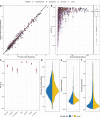Using fecal immmunochemical cartridges for gut microbiome analysis within a colorectal cancer screening program
- PMID: 36794815
- PMCID: PMC9980522
- DOI: 10.1080/19490976.2023.2176119
Using fecal immmunochemical cartridges for gut microbiome analysis within a colorectal cancer screening program
Abstract
The colorectal cancer (CRC) screening program B-PREDICT is an invited two-stage screening project using a fecal immunochemical test (FIT) for initial screening followed by a colonoscopy for those with a positive FIT. Since the gut microbiome likely plays a role in the etiology of CRC, microbiome-based biomarkers in combination with FIT could be a promising tool for optimizing CRC screening. Therefore, we evaluated the usability of FIT cartridges for microbiome analysis and compared it to Stool Collection and Preservation Tubes. Corresponding FIT cartridges as well as Stool Collection and Preservation Tubes were collected from participants of the B-PREDICT screening program to perform 16S rRNA gene sequencing. We calculated intraclass correlation coefficients (ICCs) based on center log ratio transformed abundances and used ALDEx2 to test for significantly differential abundant taxa between the two sample types. Additionally, FIT and Stool Collection and Preservation Tube triplicate samples were obtained from volunteers to estimate variance components of microbial abundances. FIT and Preservation Tube samples produce highly similar microbiome profiles which cluster according to subject. Significant differences between the two sample types can be found for abundances of some bacterial taxa (e.g. 33 genera) but are minor compared to the differences between the subjects. Analysis of triplicate samples revealed slightly worse repeatability of results for FIT than for Preservation Tube samples. Our findings indicate that FIT cartridges are appropriate for gut microbiome analysis nested within CRC screening programs.
Keywords: 16S rRNA sequencing; FIT; Microbiome; NORGEN; colorectal cancer.
Conflict of interest statement
No potential conflict of interest was reported by the author(s).
Figures





References
-
- Vuik FE, Nieuwenburg SA, Bardou M, Lansdorp-Vogelaar I, Dinis-Ribeiro M, Bento MJ, Zadnik V, Pellisé M, Esteban L, Kaminski MF, et al. Increasing incidence of colorectal cancer in young adults in Europe over the last 25 years. Gut. 2019;68(10):1820–1826. doi:10.1136/gutjnl-2018-317592. - DOI - PMC - PubMed
Publication types
MeSH terms
Substances
LinkOut - more resources
Full Text Sources
Medical
